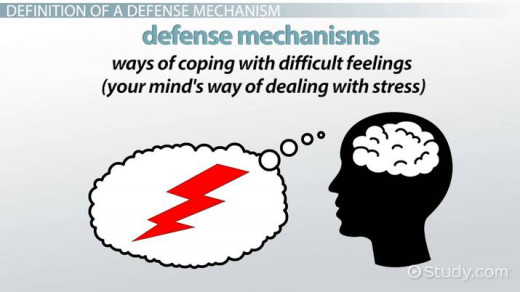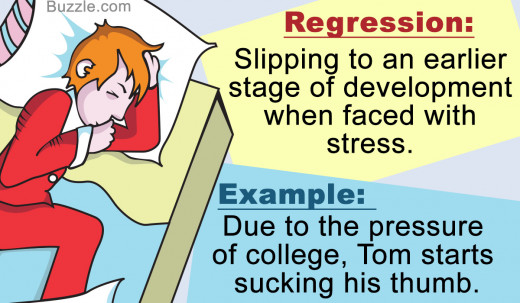- HubPages»
- Health»
- Mental Health»
- Stress Management
Some Common Defense Mechanisms

What is Defense Mechanism?
The theory underlying here is a chief feature of the Psychoanalytic theory, formulated by Sigmund Freud in 1890s, that is Defense mechanisms (DMs). Defense Mechanisms can be viewed as a distinctive set of cerebral maneuvers that may lessen the fretfulness rising from intolerable or potentially detrimental inducements. The term along with its very concept was first used by Sigmund Freud at the turn of the century and then later on was elaborated more unequivocally by Ana Freud in the mid-1960. Defense mechanisms are a technique of muddling through with fretfulness, plummeting stress, and reinstating a sense of equilibrium to an individual’s emotional involvement. Defense mechanisms transpire on an insentient level and are inclined to garble veracity to brand it easier for the individual to cope with. Defense mechanisms, in a way, are an array of feelings, judgements thoughts, moods or behaviors that are comparatively instinctive. These reflexive emotions arise in reply to insights of cerebral peril or skirmish, or to unforeseen variation in the inner or peripheral milieu, or may be in reply to cognitive dissonance.
Anna Freud's Concept of Defense Mechanism
Anna Freud, in 1936, totaled some ten defense mechanisms which can be seen in the accomplishments of Sigmund Freud, her father, and these are Regression, Repression, Reaction formation, Undoing, Isolation, Introjection, Projection, Reversal into the opposite, Turning against one's own person, and Sublimation or Displacement. Equally, Freud premeditated defense mechanisms, nonetheless Anna consumed some extra stretches of time and investigation upon five chief mechanisms which are Regression, Repression, Reaction formation, Projection, and Sublimation. All the defense mechanisms are rejoinders to fretfulness and in what way the cognizance and insentient cope with the hassle of a communal state.
Whenever these defense mechanisms are employed by the individuals every now and then, then they may intervene with an individual’s aptitude to tell the difference amid what is existent and what is non-existent. Defense mechanisms are normally employed separately or, at times, may be in a mishmash with one another. These reactions are used to erratic grades relying on how perfectly they meet the need of an individual. Here are given brief details of some of the defense mechanisms.
Repression
Repression is a reaction displayed by an individual when a sensation is concealed and involuntarily forced from the cognizance to the insentient since it is understood as publicly intolerable. Repressed reminiscences might look through subliminal sources and in transformed shapes, like as reveries or slips of the tongue 'Freudian slips'. In the Oedipus complex, for instance, hostile feelings towards the alike gender parentages are suppressed and pressed down into the insentient.


Regression
Regression is returning into a premature state of cerebral progress perceived as less challenging and harmless or under pressure, re-adopting movements shown at a less matured phase of advance. Regression is a Defense mechanism suggested by Anna, whereby the ego relapses to a previous juncture of expansion generally in reply to nerve-wracking circumstances. Regression works in the form of withdrawal, empowering an individual to psychosomatically return back into a time-period when the individual sensed safer. Whenever we are anxious or startled, our comportments often grow into more juvenile or embryonic. A kid might start to suck his thumb once more or damp the cradle at the time they want to expend some spell of time in the sanatorium. Youths might chuckle hysterically when exposed into a communal position concerning the contrary gender.
Projection
Projection can be viewed as a psychosomatic defense mechanism suggested by Anna Freud where a person pledges undesirable views, emotions and intentions onto any other being. In projection a person holds a sensation which is taken as communally intolerable and as an alternative of confronting it, that sensation or insentient impulse is realized in the reactions of other persons. Feelings which are customarily proposed onto other persons are the ones which would grounds guiltiness like violent and sensual whims or feelings. As an example, you may have hatred for somebody, however your super-ego voices to you that such a abhorrence is obnoxious. You may resolve the issue by considering that you are hated by them.
Sublimation
Sublimation is viewed like the most conventional mechanisms, a countenance of fretfulness in publicly conventional means. Sublimation is quite alike to the displacement, nonetheless it occurs at the moment when an individual try to relocate his intolerable feelings into the manners which are productive and communally tolerable, instead of disparaging undertakings. A great number of renowned artists and choirs have had calamitous lives and therefore they did use the medium of musical art to pronounce their feelings. Games are also an instance of pushing our sentiments i.e. aggression into something which is productive.

Denial
Defending the individual from hostile features of nature by declining to recognize, admit, or confronting them. It encompasses a knockback to admit veracity, therefore hindering exterior trials from mindfulness. Denial is used by a lot of people in their daily routine lives so that to evade confrontation of excruciating moods or zones of their life that they do not want to acknowledge. For instance, a hubby might decline to spot palpable cyphers of his spouse’s faithlessness. A schoolboy may deny to distinguish his evident deficiency in his preparations for his exams.
Rationalization
Making attempts to demonstrate individual’s proceedings “made sense” or were vindicated. It involves a cerebral misrepresentation of the actualities to brand an event or an impulse less menacing. People do this often enough on a fairly cognizant degree while they offer their selves with justifications. Nonetheless for numerous individuals, with complex egos, giving justifications comes so frequently that they hardly get an awareness about using this defense mechanism. In another sense, several of the individuals are fairly ready to trust their falsehoods. Whenever an individual gets into a state hard to welcome, he would make up a rational proof that why that thing happened. As an instance, an individual may define a natural tragedy as the will of God.
© 2019 Khurram Shehzad








